
Tenaya
September 2011
Part One
Introduction to
Vanuatu
| |
| HOME |
| About Tenaya |
| About Us |
| Latest Update |
| Logs from Current Year |
| Logs from Previous Years |
| Katie's View |
| Route Map |
| Links |
| Contact Us |
![]()
September 21, 2011
Active volcanoes. Deep forests. Pristine bays. Rugged, green mountains. Earthquakes. Ash plains. Bamboo huts. Chiefs. Pigs. Fruit trees and vegetable gardens. Cyclones. Kava. Cannibalism. Cargo cults. Malaria. The islands of Vanuatu have a colorful history and are inextricably intertwined with nature. It feels as though we have sailed back in time to arrive when the earth was young and volatile with indigenous clans living in small villages along picturesque bays and deep in the bush.
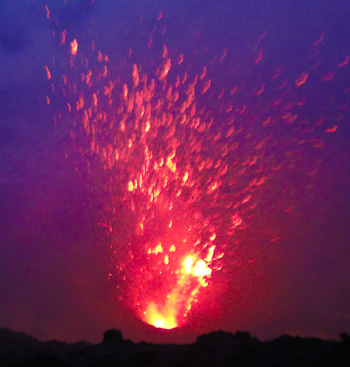
Vanuatu is a chain of 83 islands that run roughly north to south, shaped like a Y, between Latitudes 10 to 20 degrees South. The country lies west of Fiji, east of New Caledonia, south of the Solomon Islands and north of New Zealand.

The people are Melanesian whose ancestors came from further west more than three thousand years ago. Their skin is dark and their hair is thick and nappy. Some kids are nearly blonde. Everyone's eyes sparkle. They are small in stature, strong and fit.
The ni-Vanuatu, as the people here are called, are incredibly kind, hospitable, polite and happy. Strangers will immediately be taken in and offered whatever the village can provide, even if that means someone goes without.
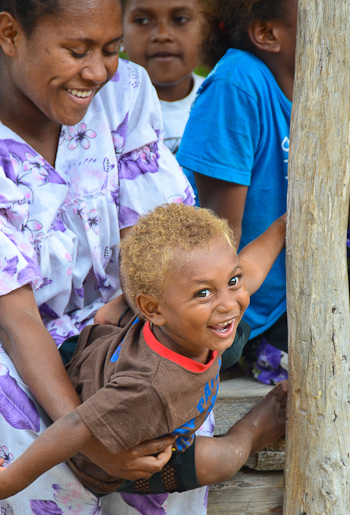
Missionaries arrived in the early 1800's. Many were eaten. They persisted and Christianity infused the kastom (customary) beliefs which are steeped in spirits, rituals and magic. The last officially recorded act of cannibalism occurred on Malekula in 1969. It is hard to believe these kind people killed and dined on their brethren until you see them comfortably club a pig to death with a few swift blows to the head.
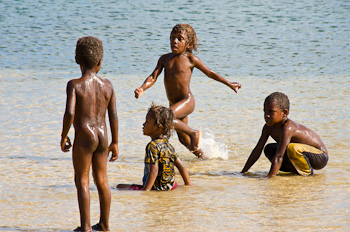
Vanuatu gained independence from a condominium government jointly administered by France and Britain in 1980. Among other rights, the constitution guarantees freedom of religion. Most villages have several churches along with traditional kastom followers. A couple villages on Tanna are cargo cults where they worship Jon Frum, an American who arrived by sea in 1936 and was seen as a god. He promised riches if the people would abandon the teachings of missionaries, some of which forbade dancing and kava drinking.

People move to the rhythm of the day, the position of the sun and the cycle of the crops. Most islands have little electricity, only what is provided with solar panels and gas generators. Houses, which are usually pandanus leaf huts, are lit by candles, flashlights or the occasional solar powered light. In contrast to the stark and primitive setting, many people have mobile phones and some have laptops and MP3 or DVD players. It is an odd dichotomy to have the man who has paddled up to our yacht in his hand hewn outrigger canoe to trade freshly caught fish for batteries, to be suddenly interrupted by the ring of his mobile phone.

Every person from the age of five onward is acutely adept with a bush knife. Children with knives nearly as long as their limbs deftly wield them to open coconuts or chop plants.
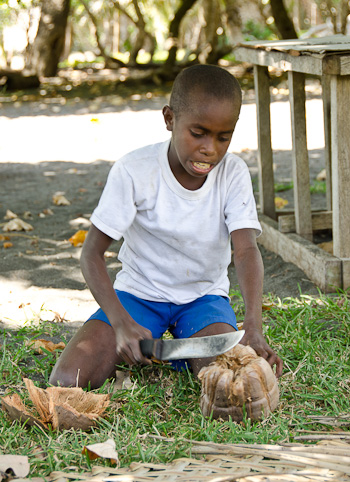
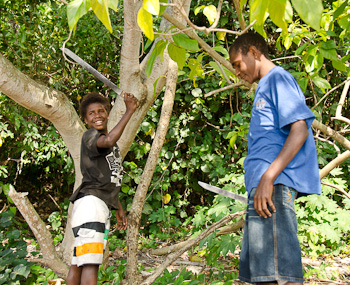
Everyone has a place in the village which operates like a cooperative for the benefit of all. Men and women spend much time in their gardens cultivating and harvesting food while others fish from shore or from their canoes with lines or nets. They keep pigs, goats, cows and chickens.

We find it refreshing and quite interesting how simply the people live, yet how full and complete their lives are. Everything needed for survival comes from the land or sea. Trading fruit, veggies or fish with yachties provides a few extra gadgets and clothes, and things can be bought in Vila and Louganville if one accumulates enough vatu, the currency of Vanuatu.
Most huts have dirt floors and may be covered with mats. There are no chairs, only a few stools and benches made of limbs here and there. Communal toilets and kitchens are separate from houses. Some villages have plenty of water, others have none. Some have vast gardens, others have very little in the way of crops. When a cyclone rips through, which happens regularly, most of the houses and crops are wiped out. People die during storms and in the aftermath. Villages do not stockpile rice or other food for such occurrences. They rely on whatever the government can provide. Then they replant, rebuild and go on.
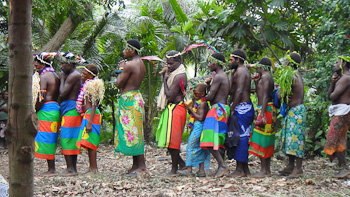
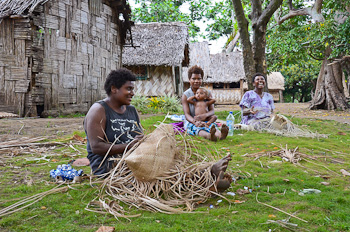
Women gather together to tend the children, gardens and pigs. They sit on the grass or on woven mats weaving natural fibers into mats or baskets, or working on some other project while talking quietly among themselves. They smile and laugh often.

Men congregate to fish, build things and just be together. Hearty laughter, with no hint of maliciousness, punctuates their spirited conversations held in one of over one hundred local languages. All ni-Vanuatu speak Bislama which is the national pidgin language, and many also speak English or French, depending on which school they attended. They also speak those languages of family members in other villages.
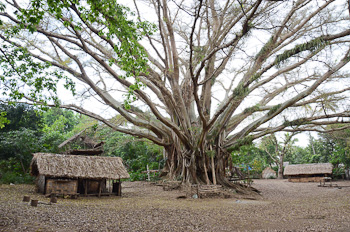
Villages a short distance apart will have completely separate languages. This seems strange until you realize the natural barriers between them, and the history of capturing and eating men of other tribes. Isolation was key to survival.
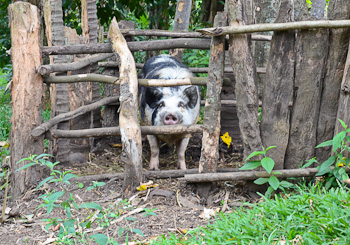
Pigs are the ancient currency of Vanuatu. Men with many pigs are rich. Pigs are lent and borrowed and accumulated and presented as gifts and butchered on festive occasions. Tusks are valuable. Boars are castrated and the upper teeth removed to allow the lower teeth to grow continuously. After seven years the tusks complete a loop and are very valuable. Another seven years creates another circle, and is even more valuable. Rarely, a pig lives long enough to form a third ring. One of these was given to Queen Elizabeth.
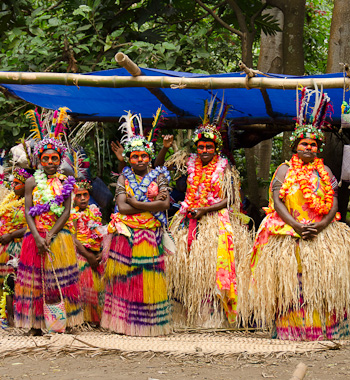
Feasts are thrown for special occasions and great feasts are thrown during festive ceremonies. Women spend the entire day before preparing laplap, the national dish which is usually some sort of meat tucked inside glutenous manioc, wrapped in banana leaves and baked in the ground.
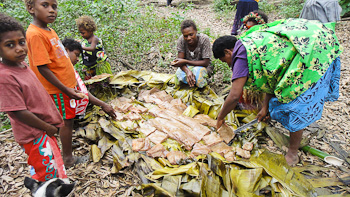
Ceremonies are an important part of the history and culture. Regardless of current religious affiliations, come ceremony time, everyone participates in the kastom dress and dance. Our local friend, Winnie, invited us to her village for a day filled with ceremonies beginning with a wedding, then a circumcision ceremony, and followed by kastom dancing by men of several villages. A truly remarkable day! Story and photos will be added soon.
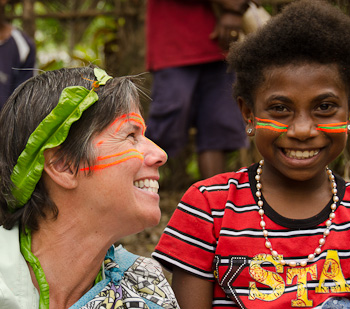
Kava. Made of ground or chewed roots of the Piper methysticum plant mixed with water and pressed through some sort of fabric to create a sooty, slightly peppery, fairly awful tasting potion. A half a coconut shell is dipped into the liquid and offered first to the chief, then to any honored guests and finally to the men of the village according to rank. You must drink it all in one go. Once you've come to terms with the unpleasant flavor, the effect is not bad. Quite nice, Jim and I have decided.

Lips tingle and get a little numb; sometimes inside the mouth does too. The mind goes to a serene and mellow place and uttering anything with more than one syllable is entirely too much trouble. Rather, one is compelled to admire the beauty of the surroundings in contemplative silence.
A nakamal, the place where kava is prepared and served each afternoon before sunset, is the complete opposite of a bar. People become less noisy as time goes on. There is a quiet camaraderie. Most people only have one bowl, maybe two. It is traditionally drunk only by men, but in some places women are now allowed to partake.
.jpg)
We are moving through Vanuatu very slowly, savoring our time with the kind, humble, hard-working local people we meet. They are quick to embrace us when we are friendly, respectful and curious. One young woman who guided us to a fumerole on Tanna said she liked that I spoke with her. She said many yachties and other tourists do not. I said some people from other places believe it is not polite to talk too much, but that we are from California and talk to everyone. She laughed and said they were more like that. Then she offered to take us to other interesting places the next day. We had made another friend.
Go to September 2011 Part Two - Aneityum, Vanuatu
Photo Gallery: Vanuatu Children